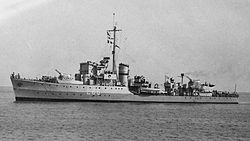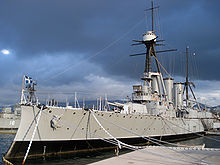Pindus (L65)
|
The Pindos
|
||||||||||||||||||||||||
|
||||||||||||||||||||||||
|
||||||||||||||||||||||||
|
||||||||||||||||||||||||
|
||||||||||||||||||||||||
The Pindos (L65) of the Royal Greek Navy was a destroyer escort the British Hunt Class of type III , which for the British Royal Navy had been built. The ship was commissioned by the Greek Navy in 1942 as the first of four identical destroyers and was used under British command.
The destroyer remained on loan after the war in Greek service, which had a total of eight Hunt-class ships from 1946 to 1959. In 1959 the Pindos was canceled, formally returned to Great Britain, and scrapped the following year.
History of the ship
The ship was ordered as a destroyer escort on August 23, 1940 as part of the British war budget of 1940 at Swan Hunter in Wallsend along with other Type III ships of the Hunt class. The shipyard had already received four of the pre-war orders (Type I) and was the main supplier of these escort destroyers with eight and four construction orders from the war building programs in 1939 (Type II) and 1940 (Type III). The keel of the 13th order with construction number 1643 took place on April 3, 1941 and it was launched as a Bolebroke on November 5, 1941. In 1942 the Royal Navy had difficulties manning its ships and therefore gave ships to the Allied navies. This procedure had already started in May 1940 when the destroyer Garland was made available to the Polish Navy.
The Greek Navy escaped to Egypt to the British in 1941 with an old ironclad, six destroyers and five submarines. Her largest ship in July 1942 was the old armored cruiser Georgios Averoff , her most modern surface ship was the British-built destroyer Vasilissa Olga similar to the H-class . Many of the ships of the Greek Navy that escaped during the German attack on Greece were outdated or in need of repair. The British decided to lend the Greeks four new Hunt destroyers, which came into service under the Greek flag as Adrias (ex-Border), Kanaris (ex-Hatherleigh), Miaoulis (ex-Modbury) and Pindos . Three newbuildings came from Swan Hunter in Wallsend and the fourth ship from the neighboring High Walker shipyard from Vickers-Armstrong , so that the Greeks only had to form an acceptance and training command in Newcastle .
As the first ship, the Bolebroke was put into service on June 27, 1942 as Pindos , which had been taken over by the Greek Navy during the final equipment on June 4. The ship was named after the Pindus Mountains , in which the Greeks successfully repulsed one of the attacks by the Italians on Greece in early November 1940.
War missions
The Pindos , like almost all units of this size, first began their service with the Home Fleet in Scapa Flow .
The operational area of the new Greek ships, however, should be the eastern Mediterranean with Alexandria as a base. On August 12, she began to move to the planned area of operations, using the ship for various escort tasks on the march around Africa to Egypt. First she escorted a motorboat flotilla to Gibraltar. This was followed by a convoy with military supplies and troops ( WS 22 ) to Freetown together with the British Derwent . On November 15, the Pindos arrived in Alexandria, which was reached by the sister ships Kanaris and Miaoulis by December 11 .
Before that, immediately after her arrival , the Pindos belonged to the security units of Operation "Stoneage", with the required goods on the freighters Denbighshire (8393 BRT), Bantam (NL, 9312 BRT), Robin Locksley (US, 7000 BRT) and Mormacmoon (US , 7939 GRT) should be brought to Malta. The Greek destroyer was part of a flotilla of ten Hunt destroyers that immediately secured convoy MW 13 . For this purpose, the 5th cruiser squadron with five light cruisers and the 14th destroyer flotilla with seven fleet destroyers formed a cover formation. The advance in Libya made it possible to give the convoy air defense over a large part of the march, and the possible attack corridor for the Axis powers was considerably reduced. After the first unsuccessful bombing the cruisers turned up on Euryalus at the height of Derna from of November 17 in the early evening. A little later, Italian torpedo pilots discovered the cruiser association and scored a hit on the Arethusa . The badly damaged cruiser caught fire, 156 men died on board and 43 were seriously injured. Despite the list, the Petard managed to haul the cruiser into Alexandria in three days.
Occasional air strikes brought no further success, but the convoy marching on to Malta remained undetected. In the first hours of November 20, the Euryalus , the ten Hunt destroyers and the four undamaged freighters arrived in Malta with a cargo of 35,000 t. They ensured the continued existence of Malta as an operational base for months, especially since the journeys of the fast mine- layer Welshman were retained, who quickly and specifically transported goods in short supply to Malta and who also arrived in Malta before and after the successful convoy with such goods.
After further security tasks in further supply transports to Malta or on the North African coast, the Pindos formed a new, multinational flotilla from March 1943 with the Greek sister ships Kanaris and Miaoulis and British hunt destroyers Aldenham , Beaufort and Belvoir .
At the beginning of July 1943, the Greek Hunt destroyers were part of the security forces during the Allied landing on the south and south-east coast of Sicily ( Operation Husky ), with the Adriatic now also arriving in the Mediterranean.
When securing the supply trips, the Pindos succeeded with the British Easton on August 22, the sinking of U 458 near Pantelleria , which had to surface after depth charges and was rammed by the Easton . The British ship, which failed until September 1944, towed the Pindos to Malta and recovered 43 men from the submerged submarine. The Pindos then took on similar tasks during the Allied landing near Salerno ( Operation Avalanche ) before they were seconded to the Aegean at the end of September .
There, after the Italian surrender on September 8, 1943, the British had tried, without US support, to take possession of the islands of the Dodecanese, which had been under Italian rule since 1912, by preparing "Operation Accolade" . This failed particularly in the case of Rhodes , where the Wehrmacht stationed there under General Kleemann attacked the numerically superior Italians and forced them to surrender. The British succeeded in occupying Kastelorizo , Kos , Kalymnos , Samos , Leros , Symi and Astypalaia , while the Germans occupied Karpathos , Kasos and the Greek islands of the Sporades and Cyclades , which were occupied by Italians . Kos (Eisbär company) and Leros should also be recaptured. The Hunt destroyers Aldenham , Pindos and Themistocles had successfully transported supplies to Leros, were in the sea area around Kos on October 3, 1943 and had knowledge of the approaching German invasion convoy through aerial reconnaissance, but could not intervene due to lack of fuel.
In the nights of 12./13. and 13./14.11. British destroyer groups searched unsuccessfully for German transport ships that supported the landing on Leros, carried out as "Operation Leopard". The Pindos searched together with the flotilla leader Faulknor and the Beaufort . The group fired at German land targets on Leros on both nights, but then had to run again due to lack of fuel. When the British-Italian occupation of Samos surrendered on November 22nd, the Germans had completed the reconquest of the Dodecanese.
Because of the dispute over a new Greek government in exile, in which the resistance groups fighting at home were adequately represented, mutinies broke out among Greek associations in Egypt at the end of March 1944. The destroyer escorts Miaoulis and Pindus also refused to leave Alexandria to move to Taranto . The officers of the Pindos were thrown overboard by the mutinous sailors. A British liaison officer was able to mediate and the Pindos finally left with new officers after a week with the Miaoulis to Italy.
In August 1944, the Pindos escorted a convoy with supplies to the landing area in southern France. Together with the meanwhile sixth Greek hunt destroyer Kriti, she stayed for a while to secure the landing section and its supply off the coast of southern France.
On November 6th to 9th, 1944, the Pindos escorted the return of the so-called Rimini Brigade on the steamer MS Alkantara from Taranto to Athens, which was regarded as particularly loyal to the king . From the end of September 1944, the Pindos like Themistocles , Kriti , Kanaris , Miaoulis and the destroyer Navarinon belonged to the "British Aegean Force", which with seven escort carriers, seven light cruisers, seven other fleet destroyers and six other destroyers escorted the occupation of the Greek evacuated by the Germans Islands and mainland parts supported ("Operation Manna"). The Greek units supported the individual landings if necessary with preparatory shelling, artillery support during the landings and attacks on the withdrawing occupiers.
End of service
The Pindos remained in service during the Greek Civil War and was removed from the fleet list and formally returned to the Royal Navy in September 1959. It was sold for demolition in Greece in 1960.
Greek hunt destroyer
| Surname | ex HMS | Shipyard | Launch | Delivery RN | in service GR | Type | off-duty |
|---|---|---|---|---|---|---|---|
| Pindus | Bolebroke | Swan Hunter | November 5, 1941 | ==> | 06/27/1942 | III | September 1959 |
| Adriatic | Border | Swan Hunter | 02/03/1942 | ==> | August 5, 1942 | III | October 22, 1943 mine hit |
| Kanaris | Hatherleigh | Vickers Armstrong | December 18, 1941 | ==> | 08/10/1942 | III | 1959 |
| Miaoulis | Modbury | Swan Hunter | 04/13/1942 | ==> | 11/25/1942 | III | September 23, 1960 |
| Themistocles | Bramham | Stephens | 01/29/1942 | 06/16/1942 | 07/10/1943 | II | December 12, 1959 |
| Kriti | Hursley | Swan Hunter | 07/25/1941 | April 2, 1942 | November 2nd, 1943 | II | December 12, 1959 |
| Admiral Hastings | Cowdray | Scotts | 07/22/1941 | 07/29/1942 | Not | II | 23 Aug 1944 after a long repair RN again |
| Aegion | Avon Vale | John Brown | 10/23/1940 | 02/17/1941 | Not | II | Apr. 14, 1944 RN again after long repairs |
| Adriatic Sea (II) | Tanatside | Yarrow | 04/30/1942 | September 4, 1942 | 1946 | III | August 1962 |
| Astings | Catterick | Vickers Barrow | 11/22/1941 | 06/12/1942 | May 1946 | III | 1963 |
| Aigaion | Lauderdale | Thornycroft | August 5, 1941 | December 24, 1941 | May 1946 | II | December 1959 |
Individual evidence
- ^ Hellenic Navy General Staff website
- ^ Rohwer: Chronicle of the naval war. P. 377.
- ↑ Herzog: German UBoote. P. 274.
- ^ Rohwer, p. 383
- ↑ Themistocles ex HMS Bramham Type II, 1942 with the RN , since July 1943 fifth Greek Hunt destroyer
- ^ Rohwer, p. 389
- ^ Rohwer, p. 400
- ^ Rohwer, p. 483
literature
- Bodo Herzog: 60 years of German submarines 1906–1966. JF Lehmanns Verlag, Munich 1968.
- HT Lenton: Warships of the British and Commonwealth Navies. Ian Allan, 1969,
- Antony Preston: Destroyers. Hamlyn, ISBN 0-600-32955-0 .
- Jürgen Rohwer , Gerhard Hümmelchen : Chronicle of the naval war 1939-1945. Manfred Pawlak Verlag, Herrsching 1968, ISBN 3-88199-009-7 .




